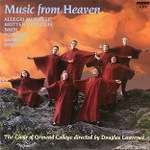|
Back
05/02/2011
“Music from Heaven”
Gregorio Allegri: Miserere
William Byrd: Sing Joyfully unto God – Beata viscera – Haec dies
Francis Poulenc: Four motets for Christmas
Benjamin Britten: Hymn to Saint Cecilia
Samuel Barber: Agnus Dei
Johann Sebastian Bach: Singet dem Herrn ein neues Lied, BWV 225
The Choir of Ormond College, Douglas Lawrence (conductor)
Recorded in Sion, Switzerland and Melbourne, Australia (1996) – 60’
Move Records #MD3181 – Booklet in English with texts in original languages except for Miserere

The title “Music from Heaven” certainly allows for a broad enough program of music, and The Choir of Ormand College obliges with a disc sampling nearly 400 years of choral music. This certainly showcases the ensemble’s range, but also highlights some weaknesses in their approach.
The choir sings with a straight, steely sound that may not be to everyone’s liking, but is very effective, particularly on the first half of the disc. This isn’t a warm straight sound as so often characterizes an English choral sound, mind you (think Harry Christophers’ “The Sixteen”). These singers from Melbourne, Australia present a much more forward and raw sound that, while not unpleasant, is striking.
The first four selections, the booklet notes, were recorded in the Basilica of Valère in Sion, Switzerland and they are, by far the most successful. The disc opens with Gregorio Allegri’s Miserere. The choir’s distinct sound is extremely well suited for this piece, with spot-on intonation and stunning chant phrases. One would swear that the chanting tenors are one voice with some natural acoustic reverb, but this is not the case. The chant is that convincing. Special mention should also be made of soprano Nina Wellington’s stunning high soprano solo.
The next pieces are a set of three by William Byrd. Like the Allegri, these Renaissance pieces fit this choir like a glove. They are sung with conviction and virtuosity. Sing Joyfully is the highlight of the set; the group sings with a real spirit of text and musical sensitivity with counterpoint entrances well defined leading to a wash of polyphonic textures.
Unfortunately, the rest of the disc isn’t quite as successful. The remaining songs were all recorded in Melbourne, Australia (no further details were given). While the tracks recorded in Sion are spacious and wide, with a well-captured resonance, and bright clear vocal sound, the remaining are not quite as clear and rich. Text is lost in thick textures and reverb isn’t as convincing.
Musically, the Poulenc, Britten and Barber aren’t comfortable for this ensemble. The notes and rhythms are well executed, but there is a certain authenticity and motive missing from these “modern” works. The Poulenc is particularly bizarre in this regard. Instead of highlighting the composer’s compositional uniqueness and strengths, they are glossed over. “Hodie Christus natus est” is the most successful of the set with Poulenc’s rhythmic and textual bite brought to life by a spirited reading.
The Britten is really a mixed bag with some fine musical execution, but schizophrenic sounds at the extremes of the ranges for the tenors, and very little contrast. Phrases hang and end abruptly; articulation is not particularly dramatic. There is some storytelling of the fascinating Auden poem, but very little mystery and affect. The Barber is a cold reading that is neither moving nor impressive. The tempo is quicker than we are used to hearing, but not much is made of the opportunity for contrast. In the end, it comes and goes without much of an impact.
The Bach Singet dem Herrn ein neues Lied, which closes the disc, puts the choir back in its comfort zone, but the singing and performance aren’t as comfortable as the first pieces. The “Singet” entrances are emphasized, but the florid, difficult lines are labored without much nuance or shape. There is very little contrast or exposure of structure, which unfortunately makes the Bach not particularly enlightening or enjoyable.
While the disc is, on the whole, very uneven, there are some wonderful moments in the first four pieces. One can see why this group, in a glorious acoustic, would be worth hearing: its distinct sound and skill are very well suited for this early music style. Unfortunately, their versatility falls short in the more modern pieces which are lacking in contrast and nuance.
Matthew Martinez
|